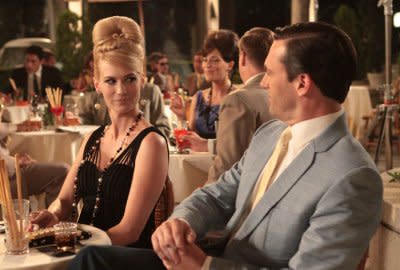"Mad Men": Is It Better If You're in a Relationship?

This Sunday night, it's Valentine's day all over again. Though this time, the celebration starts and ends in front of the television, when the critically acclaimed cable series, "Mad Men" returns for a new season. Fashion magazines, television critics, bloggers and avid followers of the series are frothing at the mouth. But no one is more excited than couples. Technically, it's an excellent show, but it's even better if you're in a relationship.
Single when the show first aired, I watched five episodes back to back, alone in my apartment (well, there were cats). Despite the rich art direction, the plot felt labored, the characters were too good looking to relate to. I tuned out until season three, when I found myself in a new relationship. In reaping the benefits of couple-dom--behind sex and splitting the cost of wedding gifts-- came watching "Mad Men".
"You can't underestimate the power of the show's time-slot, even in the era of Hulu and DVRs," says Meredith Blake, a TV critic, covering this season of the series for the Los Angeles Times. "Ten o'clock on a Sunday night is a very cozy hour if you're in a couple. Most people are at home, taking it easy-- not wanting think about going back to work. There's something about that hour that makes you grateful to have a partner to endure the week with. It's like a lazy date night."
In the company of a partner, I discovered how addictive the show-- from the weekly ritual to the plight of the characters-- really is. Several critics have agreed that the first season started off slow and picked up momentum in the episodes and seasons since. But there has to be something to the fact that it's not the kind of show you watch with a gaggle of girlfriends (see "The Bachelorette") or alone in the dark ("Intervention") or with mom (7 straight hours of HGTV). So why is it best savored with a partner?
One reason may be because it's comforting. "On a visceral level, seeing the train-wrecks of almost all the relationships on "Mad Men" may make viewers feel better about their own quarrels, problems and silent grudges," says New York Daily News TV critic, David Hinckley. "Roger Sterling is the classic oblivious sleaze, picking up the trophy wife like a six-pack at the grocery store. Don just kept getting quietly worse. Remember when he's putting the moves on a stewardess. She says she's engaged and jokes that this might be her last chance for a fling. He replies, 'I've been married a long time. Trust me, you get lots of chances.' I think a lot of viewers silently could have been thinking, 'whoa, at least my partner isn't him. Or I'm not him.' "
Even if they are, the show is beautifully shrouded in 'the way things were'. Nobody smokes in offices, drinks whiskey at noon with productive results and shamelessly cheats without regrets anymore. At least we don't think they do. It makes you grateful that you're not stuck in the 60's, despite the fact that it looks so visually appealing.
The pace of the show is also reminiscent of a slow dance. Watching it alone can be tedious, but with a partner, you can bask in the simmering romance. "There was a wonderful scene last season, in which Don and Betty flew to Italy for a weekend, last-minute," says Hinckley. "When they got there, Betty went to a cafe and sat there looking like an Audrey Hepburn character. Don approached her as if he were Marcello Mastroianni, the elegant continental. In this apparently spontaneous, unspoken agreement, they both pretended to be the characters they were playing. It was a wonderful moment for both of them." And for the couple on the couch, who soaked in their rekindling. "I think it suggested they are both at heart classic romantics undermined by, alas, the tragedy of life." It's a sentiment that brings two people together, for a moment, in spite of their grievances.
Another reason it resonates with partners, of any sexual orientation, is that the show mimes the two sides of a relationship. Both the masculine and feminine, the satiric and the earnest. Pete Campbell's insecurities and Roger Sterling's twisted humor are portrayed as parody. But when we move to look through the lens of someone like Sally Draper, the world becomes more about heartbreak than humor.
The perspectives are as balanced as the distribution of male and female characters-- from the style, which has fueled the covers of both men's and women's fashion magazines, to the issues. The pressures of being a man in an era of closeted homosexuality, a single income family, and a burgeoning woman's movement is as equally explored as the stresses of being a tragically lonely homemaker or a single working woman.
Whereas other shows are designed for the next day at the office watercooler, "Mad Men" is for pillow talk.
"Joan's relationship with her two-faced surgeon fiance/husband was explored with ferocious intensity -- which is what made the rape scene so stunning," says Hinckley. "The show doesn't exploit relationships; it presents them and explores why they turn out as they do. They don't feel like they were created just to advance the plot."
The biggest reason that the show fares so well with couples may boil down to one thing: Joan. "We don't get annoyed when our partners ogle her," notes Blake. "In fact, we're right there with them--we want to stare at Joan and raid her closet, but she's such a richly drawn character that we also feel deeply invested." She embodies both the hyper-masculine confidence of Don Draper and the hyper-feminine vulnerability of Betty Draper--in her glassine skin alone.
She's the kind of character that compels--even the least smug partner--to use the term "we" with abandon. "We love Joan. We think she's beautiful." And how often does a couple agree on something like that?
